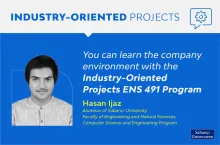08/10/2021
Sabancı University has opened its Digital Campus in Altunizade, Istanbul with an infrastructure investment, of which there are only a few examples in the world in terms of educational technologies. On its new campus, Sabancı University will host businesspeople and professionals from all over Turkey through its graduate programs tailored to needs of the business world. Thanks to HyFlex technology, which is used for the first time in education in Turkey, students will receive education wherever they are, in a digital environment that fells exactly like individual or classroom learning. The Digital Campus will host an infrastructure through which students can come together, produce and develop projects with representatives of the business world.

The Digital Campus was designed to be the focal point of all the work of Sabancı University in digital field. The opening ceremony of the Digital Campus was attended by Güler Sabancı, Founding Chair of Sabancı University Board of Trustees, and Yusuf Leblebici, President of Sabancı University. Guests of honor, who attended the ceremony online, were Werner Vogels, CTO of Amazon, and Pierre Dillenbourg, Associate Vice President for Education at Swiss Federal Institute of Technology in Lausanne (EPFL).
GÜLER SABANCI: “Even when you look at the Ivy League in the US, you can see only a few of such digital campus examples. Therefore, we enter such a league with our campus.”
Delivering a speech at the opening ceremony, Güler Sabancı, Founding Chair of Sabancı University Board of Trustees said the following: “I would like to start by telling you I am proud on behalf of the University to bring such an innovative and well-equipped campus to life. We started this project before the pandemic. The project was just at its early stage, and was completely renewed with the pandemic. Our Altunizade Digital Campus strongly reflects HyFlex working method, which has entered our lives so quickly and become indispensable now, and we have all the digital infrastructure this method requires.”

Highlighting that Sabancı DX is located on the same campus in Altunizade, Sabancı continued: “Established 4 years ago, DX is a company that leads the digital transformation of Sabancı Holding. It is not by coincidence that Sabancı DX and Sabancı University Digital Campus are neighbors, it is a decision. I am sure that with this campus Sabancı University will be closer to the business world including Sabancı DX.
I believe we can find solutions to many problems in the world only if we work, create and develop together. I firmly believe in the success triangle. I think we will make one of the best examples of it. We have always made exemplary projects for our country, higher education and overall education in our country. And this one is a new and the first practice for our country. There are only a few examples of such a campus in the world, like Columbia University, with which we have close cooperation. Even when you look at the Ivy League in the US, you can see only a few of such digital campus examples. Therefore, we enter such a league with our campus.
Leblebici: “It will be a meeting point for university-industry collaboration”
During his speech, Prof. Yusuf Leblebici, President of Sabancı University said it was a source of pride for him to inaugurate the Digital Campus, the first and the only example in Turkey, where digital technologies would be applied to the world of education and scientific research. He continued: “As Sabancı University, with our self-confidence derived from leading innovations all the time, we are sure that this campus will make very valuable contributions to the world of education and business.”

Leblebici said “In the light of the principle of ‘creating and developing together’, which has guided us from the beginning, we believe that this campus will play a leading role in shaping the future of university environment as a place where state-of-the-art digital educational technologies will be developed and applied.” He continued: “More than 70 classrooms and amphitheaters on our main campus in Tuzla are currently equipped with all the facilities of digital technologies offered to our students. Altunizade Digital Campus, where we are today, is a laboratory environment in real sense that aims to carry this experience one step further, and promote the use of emerging technologies like HyFlex in the field of education. As Sabancı University, we bring together digital technologies and computer science, at which we are strong and assertive, with our deep-rooted experience in education to lead in this field. The Digital Campus will also offer us the ideal environment to work and develop together with our industry partners, and be a meeting point for university-industry collaboration.”

WERNER VOGELS: “The age of digital learning is upon us.”
During his speech entitled “Developments in technology to enhance students’ learning and experiences”, Werner Vogels, CTO of Amazon CTO said: “The age of digital learning is upon us. Advances in digital technologies provide a range of ways for students to engage like never before. Sabancı’s Digital Campus is the accumulation of several different trends that I see. These will be significant drivers of change that will shape our institutions, and our lives, in the decades to come.” Talking about the use of AI in education, Vogels said: “Imagine using AI as a supplement to marking. This can go way beyond relieving faculty and student fatigue for low-level issues.” Vogels continued as follows: “AI can be used to better understand assignments and lesson delivery to predict when students may be disengaging or falling behind. And how about having a system that uses AI to track students’ progress and automatically flag for instructors and administrators troubling patterns and support early intervention? I believe the kinds of innovations that will happen at the sabancı University Digital Campus will lead to advancements that will be key in developing education, industry, and society as we move into a new era in technology.”

“Pedagogical value of augmented reality is about escaping from reality”
During his speech, Pierre Dillenbourg, Associate Vice President for Education at EPFL said, “Pedagogical value of augmented reality is about escaping from reality.” He continued: “Augmented reality is used in education with the help of simulation. A simulation is done on physical objects by using digital data. Then a desktop test is carried out to check the resilience of this simulation to external loads and issues. Augmented reality has been used more and more in teaching of architecture or engineering.”

ONLINE AND HYBRID EDUCATION INFRASTRUCTURE CAME TOGETHER ON ALTUNİZADE DIGITAL CAMPUS
Sabancı University Altunizade Digital Campus started to operate in 2020-2021 Fall semester. Providing services with its online and hybrid infrastructure, the Digital Campus has 9 hybrid classrooms, 2 professional recording studios, 2 group study rooms, a scientific showroom, a conference hall, rest and dining areas.
Private and public training sessions of Sabancı University Executive Development Unit (EDU), and Non-Thesis Graduate Programs for Professionals are delivered on Altunizade Digital Campus.




















